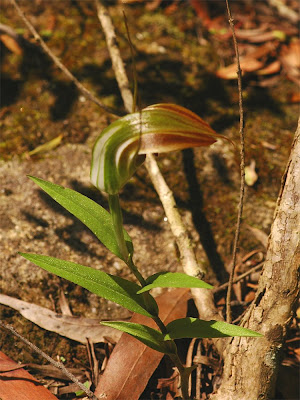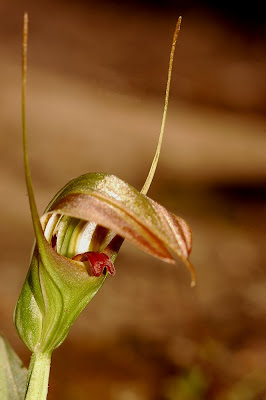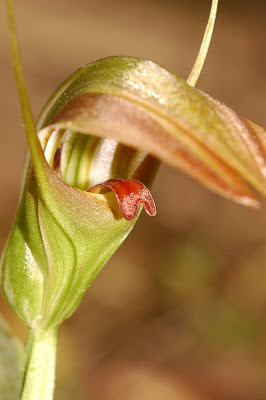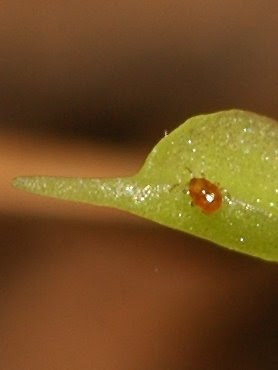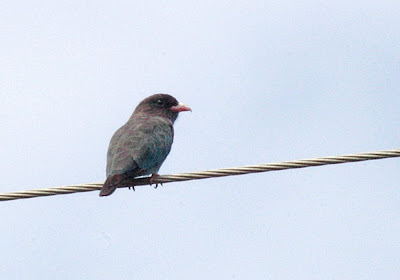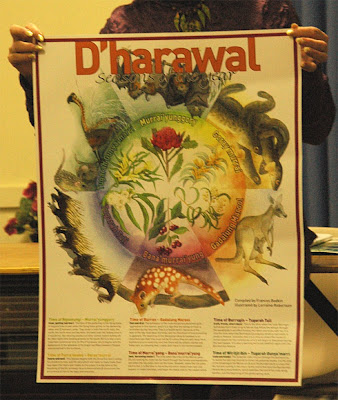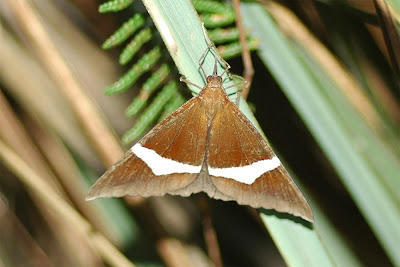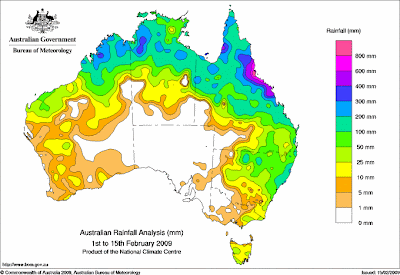I generally do not photograph "road kills" - as some people might be offended by the images. If you feel that way, kindly go no further.
Please come back tomorrow.*****
In my defence, photographing "road kills" is a great opportunity to show details of birds or animals which one normally does not see, or can only glimpse briefly, at high speed.
This is an Australian King-Parrot
(Alisterus scapularis) which had been hit by a vehicle as the bird was flying to or from a wild apple tree, growing beside the Illawarra Highway. The tree was heavily in fruit, and was attracting all sorts of birds, including Rosellas, King Parrots and several Ravens. No doubt the little birds will follow, once the large birds have opened the fruit up to the air, and yeast spores, allowing the fruit to ferment, naturally.
The bird was very freshly killed, and had presumably been hit a glancing blow, because, to put it crudely, it was in very good condition - apart from being dead! (That comment is for Tyto Tony's benefit, as I suspect he is probably a fan of The Goon Show.) After examining it, and checking its freshness, I decided to take some photos to record some details of the bird's plumage.
Here it the top view, showing head, wings, rump and tail. The green head means it is not a mature male. It could be either female or juvenile. Both have green heads.

Here it is seen from underneath. You will notice the brilliant scarlet coloured abdomen. Males have that colour on their chest and head. For a full set of images of all stages of development of Australian King-Parrots, have a look at this site, developed by Alan, of
Waratah Software.

Here is a close-up of the head. Wonderful glossy green feathers, especially around the eye. The beak is orange-red, but not quite the fully coloured beak of a mature female. Juvenile birds have black beaks. So, I conclude that this bird was probably a female, nearing maturity.
The beak of Parrots is uniquely structured, because the upper mandible is hinged (at the top of the beak) allowing them great flexibility of the beak configuration, giving them remarkable beak agility and control when eating small seeds. Although the tip of the upper mandible (when at rest) protrudes far beyond the shorter, blunt lower beak, because of the hinge in the upper mandible, its angle can be changed, relative to the lower mandible. This allows
seed eating parrots to finely crack open even a very small seed between the cutting tip of the lower mandible, and the upper mandible.
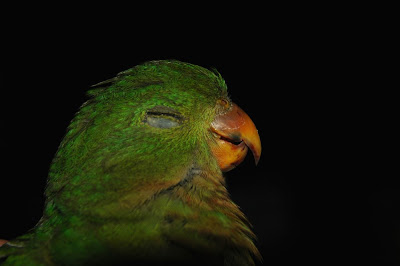
To clumsy humans, who can only wiggle our lower jaws around, that flexibility of both beaks seems quite remarkable.
This image shows the rich blue colour on the rump. This is a feature not often observed in the wild. The bird has lost some feathers.
 The structure of the Tail Feathers.
The structure of the Tail Feathers.Here is a rich green tail. The tail is very long - considerably longer and straighter than that of the Crimson Rosella.

Now I would like you to study the tail structure in some detail. Tails are very important for birds for control in flight. Expressed very simply, birds use their tails for
"steering" and for
"braking" (slowing down when landing). Click on the image (above) to enlarge it. There are three feathers clearly visible, with the shining dark central stems (the "shaft" or "rachis") clearly visible. I would like you to examine those three feathers.
- The central tail feather is very well balanced, (left and right) either side of the central shaft.
- The lowest feather, (left hand side of the tail structure) if you look closely, has shorter strands ("barbs") on the outside edge (left) of the shaft, with longer barbs on the inside edge of the tail. That is very evident close to the tip of the feathers.
- By contrast, on the high side of the tail (in this image) - (the right hand side of the tail structure), you can see the reverse of this balancing feature. Here, the shorter "barbs" are on the right of the rachis - which is of course, on the outer edge of the tail. The longer barbs are on the inside edge of the tail. This is the opposite arrangement to the individual feather example discussed above.
- We are looking at a balanced central feather in the tail structure, and two opposite-shaped feathers on the either sides of the tail - which balance each-other out - left and right.
It is all about symmetry (not of the individual feathers, but of the matched sets of feathers) which is essential to the bird's balance, in flight. This is an integral feature of the balance of the bird, in flight - part of the bird's overall streamlining and aerodynamic balance.
Under side of the tail:This next image shows the highly complex structure of the tail as seen from underneath. You can see that there are matched pairs (left and right) of tail feathers which are not full length feathers. As the tail is closed, these feathers are "filed away" sequentially. They are positioned under eachother progressively, from the longest feathers to the shortest, as you look along the tail (upwards from the tip).
Remember that in this image, we are looking from the underside of the bird. The shortest feathers would be the outermost tail feathers (as the tail is spread, in flight). Then the slightly longer feathers are next. Right down to the nearly full length feathers. Finally, the central (longest) feathers maintain their position as the tail is spread.
So, the shorter feathers would be on the outer edges, and then the entire tail would taper towards those three long central feathers, which we examined from above - in the previous image. When the bird is at rest, the short feathers are neatly folded under the longer feathers, giving the impression of a long, narrow tail.
It is obvious, however, that as the bird needs to spread its tail, for dodging left or right, in flight, or "fanning out" during a landing manoeuvre, the tail could be spread quite widely, for precise control during flight. It is a very complex structure, which the bird can operate, with perfect control, at high speed - something which birds appear to do "automatically".
Occasionally, mistakes do occur, as in this case.But, next time you watch a group of parrots fly up into a tree, remember how much control they exercise to avoid bumping into branches, or to steer around objects. These birds can fly through the dense canopy of a rainforest tree, at full speed - up to 60 Kph. Much of that "steering and braking" control comes from adjustments made to the tail feathers.
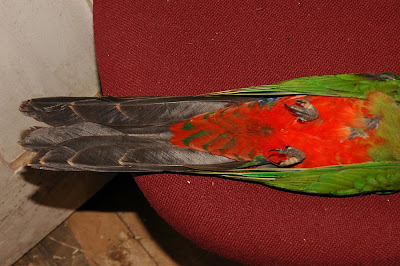
The other feature which is evident in that image is the tapered set of red and green feathers, known as the "Under Tail Coverts". The dark spot in the centre, below the feet, is where the "vent" is located. Below that is where the under tail coverts start.
Now for the wing. The wings are balanced, left wing and right wing, but the individual feathers are strongly asymmetrical. Considered overall, the two wings are balanced, with oppositely shaped feathers. Otherwise birds simply could not control their flight.
Wikipedia has an interesting article on
flight feathers of birds here.
The longer feathers, "the Primaries", the main feathers used to gain thrust in flight, are especially asymmetrical. The tapered feathers allows for gaps at the wingtip; air is forced through these gaps, increasing the generation of lift (according to Wikipedia).
You can tell how the feathers sit when the wing is closed, by noting the fine green stripe of colour on the leading edges of these feathers. The green bit is the only part of these flight feathers which is visible when the wing is closed. So the amount of "overlap" when the wing is closed increases progressively as you look further out on the wing. Judging by the very fine green edge of colour, the very furthest out feather only just protrudes beyond its nearest neighbouring feather when the bird's wing is folded closed. But in flight, it can be spread wide, to maximise the thrust and lift achieved by the bird's wing strokes.
As you come back along the wing, (closer to the body) the "flight feathers" get progressively smaller - the "secondaries" and the 'tertiales". Above the flight feathers are layers of ever smaller feathers, which are referred to as the "upper wing coverts".

It is worth noting that there is a sexual dimorphic feature on the wings of male King Parrots. The males (only) have a light green stripe on the wing coverts. This feature is strongly visible in the ultra-violet spectrum, which parrots and some other birds can see.
The
Birds on Backyards site says: "Although King-Parrots appear distinctly red and green to humans, when viewed under ultraviolet light, some feathers on the wings appear with a prominent yellow glow. Many birds have four types of cone in their retina, (compared to only three in humans) and see into the ultraviolet wavelengths." It is assumed that this highly visible patch of feathers gives the birds some competitive advantage when courting a potential partner.
This next image is simply the same wing image, cropped and reversed, to see the wing as one would see it looking outwards from the body of the bird.

If you click to enlarge the image, you will see it at maximum pixellation. You can clearly see the tapered "barbs" on the individual feathers, and the increasing asymmetry of the flight feathers, and one looks further out to the leading edge of the wing. There is one feather (3rd down from the top, in this image) where the barbs, which are normally held together by a series of minute hooks between the individual barbs, have separated, breaking the smooth line of the feather. This shows how important those minute hooks are, in keeping the aerodynamic structure of the feather. Broken feathers or feathers with the barbs separated like that, would greatly reduce the efficiency of the wing strokes. That is why birds spend a lot of their time "preening" themselves, re-aligning the barbs on their feathers, and allowing the minute hooks to join back the barbs of the feathers.
Damaged feathers are replaced by moulting, when old feathers drop out, and new ones grow to replace them.
Finally, here is a view of the legs and feet. Parrots have two forward pointing toes (which are relatively long), and two thicker, stronger, backward pointing toes (
"zygodactyly"). When the foot is closed, the forward pointing toes nestle in between the two rear toes. The claws on the rear toes are very powerful. These are the main toes used in perching. Normally parrots reach out with their beaks to chew plant seeds directly from the plant. However, the feet are also used sometimes by parrots and cockatoos, in gripping large items of food, to hold it up to the beak, when eating. Parrots are much better adapted to this method of feeding than just about any other group of birds. Owls have a similar (but not identical) toe structure, but they use their feet from grasping food, and for carrying it to a perch. But they do not hold their food up to the beak, as parrots do.
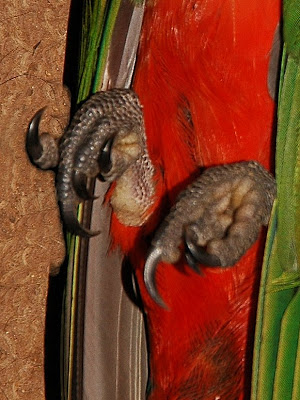
As anyone has ever observed parrots feeding on the ground will be aware, they have very short but powerful legs. Here you can see one of the legs, the lower joint, at least. You can also see how strongly scaled the legs and toes are. These scales are much thicker than in Passerines (perching birds), which tend to have long flat scales sheathing the leg bone, more or less like a thin plastic coating.
 (Photo: Weekend Australian 28.2.09)
(Photo: Weekend Australian 28.2.09) How do the Pelicans of the east coast know when to fly west to Lake Eyre? Perhaps they had read the front page of the Weekend Australian today. "Waters give lift to nature's Eyre force" (pathetic pun, by the way, dearest Sub-Editor of the Australian).
How do the Pelicans of the east coast know when to fly west to Lake Eyre? Perhaps they had read the front page of the Weekend Australian today. "Waters give lift to nature's Eyre force" (pathetic pun, by the way, dearest Sub-Editor of the Australian). I don't know if Pelicans have a barometric sensor system, which tells them there has been a massive depression (Low Pressure System) in northern Queensland. Whatever it is, Pelicans are undoubtedly moving (from somewhere) to Lake Eyre, to feast on the burst of life which follows a flood there.
I don't know if Pelicans have a barometric sensor system, which tells them there has been a massive depression (Low Pressure System) in northern Queensland. Whatever it is, Pelicans are undoubtedly moving (from somewhere) to Lake Eyre, to feast on the burst of life which follows a flood there.


